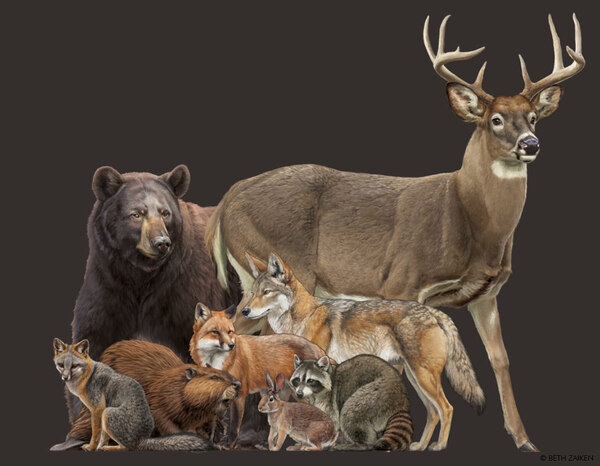Table of Contents:
Introduction: Understanding Temperate Forests and Their Rich Biodiversity
What Makes Temperate Forests Unique?
Types of Animals Found in Temperate Forests
Mammals
Birds
Invertebrates
Herbivores, Carnivores, and Omnivores
The Role of Temperate Forests in Supporting Animal Life
How Animals Adapt to Life in Temperate Forests
Seasonal Changes and Wildlife in Temperate Forests
Endangered Species in Temperate Forests
The Importance of Conserving Temperate Forest Animals
Human Impact on Temperate Forest Wildlife
Conclusion: Why Temperate Forests Are Essential for Biodiversity
Temperate forests are some of the most biodiverse ecosystems on Earth. These forests, typically found in regions with moderate climates, provide homes to a wide variety of animals. The question “Does temperate forest have a lot of animals?” is not only about the quantity but also the diversity and intricate interactions between species. In this article, we'll delve into the rich wildlife of temperate forests, from mammals to insects, and explore the role these ecosystems play in maintaining biodiversity.

Temperate forests are characterized by distinct seasons, with cold winters and warm summers. They are primarily found in regions like eastern North America, parts of Europe, and East Asia. These forests support a variety of plant life and provide diverse habitats for animals. Unlike tropical forests, which are warmer year-round, temperate forests experience more pronounced seasonal changes, which have shaped the behavior and adaptations of the animals that live there.
Temperate forests are home to a broad spectrum of animal species, ranging from large mammals to tiny insects. Here's a breakdown of the types of animals found in these forests:
Temperate forests support a variety of mammals, from predators to herbivores. Some common mammals include:
Temperate forests are also known for their diverse bird populations. Birds in these forests include:
Woodpeckers
Owls
Songbirds (e.g., robins, warblers)
Hawks and Eagles
Wild turkeys
Insects and other invertebrates play an essential role in the ecosystem. Common invertebrates in temperate forests include:
Spiders
Moths and Butterflies
Worms and Snails
The food web in temperate forests is complex, consisting of herbivores, carnivores, and omnivores:
Herbivores: Deer, rabbits, squirrels
Carnivores: Foxes, wolves, bears
Omnivores: Raccoons, bears, certain birds
Here is a detailed table of animals typically found in temperate forests:
| Animal Type | Species Examples | Role in Ecosystem |
|---|---|---|
| Mammals | White-tailed deer, Black bear, Fox | Herbivores, Carnivores, Omnivores |
| Birds | Woodpecker, Owl, Hawk, Robin | Predators, Omnivores, Seed Dispersers |
| Invertebrates | Ants, Beetles, Spiders, Moths | Decomposers, Pollinators |
| Herbivores | Deer, Rabbit, Squirrel | Plant Eaters |
| Carnivores | Fox, Wolf, Bear | Predator |
| Omnivores | Raccoon, Bear, Crows | Scavenger, Generalist Eater |
Temperate forests provide a variety of niches for animals, offering everything from dense canopy cover for birds to the forest floor’s rich layer of fallen leaves and decomposing wood for insects. These ecosystems act as both a food source and a shelter for countless species. The balance between plant and animal life in temperate forests is essential for maintaining the overall health of the ecosystem.
Animals in temperate forests have developed various adaptations to survive the seasonal changes. Some of the most notable adaptations include:
Hibernation: Animals like bears and squirrels hibernate during the cold winter months to conserve energy.
Migration: Many birds, including the migratory songbirds, leave the forest during the winter and return in the spring.
Camouflage: Animals like deer and foxes often have coats that help them blend in with their surroundings, offering protection from predators.
These adaptations are crucial for survival, as the forest undergoes significant changes with each season.
The seasonal changes in temperate forests have a direct impact on wildlife. During spring and summer, the forest is teeming with life, with animals breeding, foraging, and raising their young. In fall, animals prepare for winter by storing food or fat reserves. Winter is a time of dormancy for some species, while others, like owls and foxes, are active throughout the cold months.
While temperate forests are rich in biodiversity, some species are at risk. Habitat loss, climate change, and human activity threaten the survival of many animals. For example:
The Eurasian lynx: Once widespread, now endangered in parts of Europe.
The northern spotted owl: Threatened by deforestation in North America.
The red wolf: Native to the southeastern U.S., this species is critically endangered.
Conservation efforts are crucial to protect these species and the ecosystems they rely on.
Temperate forests play an essential role in regulating the climate, supporting biodiversity, and providing resources for humans. Protecting these forests and the animals that inhabit them is vital for preserving ecosystem services like carbon sequestration, clean water, and soil health. By maintaining healthy populations of forest animals, we ensure the long-term sustainability of the entire ecosystem.
Human activities, such as logging, urbanization, and agriculture, have a significant impact on temperate forest wildlife. Deforestation disrupts habitats, while pollution and climate change further threaten species. It’s important to engage in sustainable forest management and conservation to minimize human impact on these critical ecosystems.
Temperate forests are rich ecosystems that support a wide variety of animal species. From mammals and birds to insects and other invertebrates, these forests are home to an array of wildlife. However, with increasing threats from human activity, it’s more important than ever to protect these habitats. By understanding the delicate balance of species that thrive in temperate forests, we can take action to conserve and sustain these vital ecosystems for generations to come.
Call to Action:Let’s work together to protect temperate forests and the diverse wildlife that depends on them. Consider supporting conservation efforts, advocating for sustainable practices, and reducing your environmental footprint to help preserve these valuable ecosystems.
animal tags: Fox
We created this article in conjunction with AI technology, then made sure it was fact-checked and edited by a Animals Top editor.